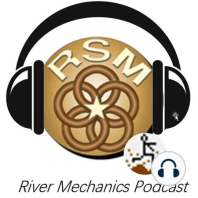56 min listen

Sediment Modeling Failure Modes and Best Practices with Four Model Developers
Sediment Modeling Failure Modes and Best Practices with Four Model Developers
ratings:
Length:
59 minutes
Released:
Mar 21, 2024
Format:
Podcast episode
Description
A couple years ago, my agency asked me to write some guidance on sediment modeling, so, I reached out to the morphological modelers I knew, and particularly the model developers who write the morphological model code other people use.I asked them about the common failure modes they have seen and best practices they teach, and realized we had all essentially spent a decade or two, learning the same principles. So when the US federal agencies held their periodic Federal interagency sediment conference (SEDHYD) last year, I invited three of the model developers I have learned from over the years (Alex Sanchez, Gary Brown, and Blair Greimann), to participate in a panel discussion on their lessons learned.And the panel was much more popular than we expected. It turns out, there’s appetite conversations like this. So, I turned on the mics and we did a little editing, and we’re running it here.Here are brief bios for our guests.:Gary Brown did his graduate work at the university of Florida and works at the Coastal and Hydraulics Lab which is part of ERDC, the Corp’s major R&D center in Vicksburg Mississippi. He’s been developing sediment models for 29 years including SEDLIB, a set of sediment algorithms that are called by ERDC’s hydraulic model, ADH or Adaptive hydraulics. Alex Sanchez sits in the office next to me. For the last 9 years, he has worked here at HEC and spearheaded the work to add 2D sediment to HEC-RAS which includes a novel formulation for the sub-grid approach. But actually Alex started developing sediment models at ERDC’s Coastal and Hydraulics Lab where he worked for 8 years, while working on the Coastal Modeling System which is still used for Corps of Engineers coastal applications. Blair Greimann got his PhD from the University of Iowa and worked at the Bureau of Reclamation’s Technical Service Center in Denver for more than 23 years, before his recent move to Stantec. While working at the Bureau Blair led the development of SRH-1D and applied this model to a range of projects including the Matilija and and Klamath Dam removals.Finally, we were lucky enough to have Doug Shields moderating this session so you will hear from him in the breaks between the four sub-topics. Dr. Shields, worked for more than 20 years at the Sedimentation Lab of the Agricultural Resource Center in Oxford MS and 10 years at ERDC and has taught at both Tennessee State and Old Miss and we were fortunate to draw Doug as a moderator. (Note: I did not mic Doug, but wanted to keep his thoughtful and winsome transitions, so his sound quality is not at the same level as the rest of the recording).After Doug and I introduced the session you will hear from Blair Greimann, Alex Sanchez, me again, and Gary Brown in that order.The conference paper associated with this session is here:https://www.sedhyd.org/2023Program/1/157.pdfThank you to the SEDHYD organizers (including but not limited to ) for hosting this conversationThis series was funded by the Regional Sediment Management (RSM) program.Stanford Gibson (HEC Sediment Specialist) hosts.Mike Loretto edited the episode and wrote and performed the music.Video shorts and other bonus content are available at the podcast website (which was temporarily down but is back up now):https://www.hec.usace.army.mil/confluence/rasdocs/rastraining/latest/the-rsm-river-mechanics-podcast...but most of the supplementary videos are available on the HEC Sediment YouTube channel:https://www.youtube.com/user/stanfordgibsonIf you have guest recommendations or feedback you can reach out to me on LinkedIn or ResearchGate or fill out this recommendation and feedback form: https://forms.gle/wWJLVSEYe7S8Cd248
Released:
Mar 21, 2024
Format:
Podcast episode
Titles in the series (27)
Episode 1:2 - Molly Wood by RSM River Mechanics Podcast